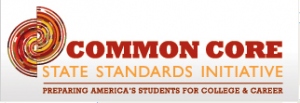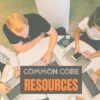Tag: common core
7 Ways Common Core Will Change Your Classroom
 The biggest pedagogic change to American education since the arrival of John Dewey is happening right now. It’s called Common Core State Standards. Its goal: to prepare the nation’s tens of thousands of students for college and/or career. If you are involved in any part of teaching, administrating, or planning, you are holding your breath, downing an aspirin, and crossing your fingers, knowing a storm is about to hit. You’ve prepared, but is it enough?
The biggest pedagogic change to American education since the arrival of John Dewey is happening right now. It’s called Common Core State Standards. Its goal: to prepare the nation’s tens of thousands of students for college and/or career. If you are involved in any part of teaching, administrating, or planning, you are holding your breath, downing an aspirin, and crossing your fingers, knowing a storm is about to hit. You’ve prepared, but is it enough?
46 states adopted the Common Core in an effort to bring consistency and uniformity to the hodge podge of state standards that dot the education landscape from California to Maine and Alaska to Florida. For most states, implementation is piecemeal, a bit at a time, with the full roll out not expected until sometime in 2015.
Besides turning your curriculum upside down, there are philosophic changes you as a teacher will have to buy into to fit the mold that is Common Core:
- Depth not width—Dig into ideas. Make them clearer, more robust. Teachers will cover fewer topics in a year, but with greater detail. Trust that the breadth of learning will come from that deeper understanding. The accepted pedagogy that similar topics be introduced every year, each with more detail, is no longer. Now, students will cover new topics at each grade level–fewer but fuller.
- Nonfiction, not fiction—Literacy and reading is likely to be comprehensive narratives rather than inference from stories. Why? Post-high school reading in both college and career is more often expository than fiction as high school grads study for college courses or receive specific training on a job. Students need to know how to perform the critical reading necessary to pick through the staggering amount of print and digital information required to thrive at the game called life.
- Evidence is required–It will be paramount that students logically and dispassionately prove their claims with organic conversations and authentic, well-understood evidence. Statements must have supporting facts that stand up under cerebral scrutiny. A claim of acceptability because it is ‘their interpretation’ will not be sufficient in a CCSS classroom.
- Speaking and listening--Anyone who thrives in the adult world knows the importance of these two skills. Now, they will be taught in the K-12 curriculum. The youngest learners will have guidelines for how to carry on a conversation–come to a discussion prepared, listen respectfully to others, take turns speaking, build on each other’s conversations, ask clarifying questions. As they advance grade levels, so too will the requirements.
- Technology is part of most/all standards--Not overtly, but teachers will find a fundamental understanding of how technology scaffolds learning to be essential in delivering Standards correctly. Many times, standards expect knowledge be ‘collaborated on, published and shared’. This is done through technology–pdfs, printing, publishing to blogs and wikis, sharing via Tagxedos and Animotos. Students and teachers will use the internet, online tools, software, tech devices as vehicles for achieving educational goals. No longer will they be ‘fun’ tools employed in the computer lab. Now, they will be integral to the curriculum. This means teachers will have to be comfortable with iPads, online widgets, Google Docs, and all those geeky tools that they admired from afar, when colleagues used them, promising they would try them ‘one day’. That day has arrived.
- Life skills are emphasized across subject areas. It’s not good enough students can write in literacy classes. CCSS expects them to communicate just as effectively in every subject. And, where critical thinking has always been fundamental to math and science, that now expands to all classes. Students must understand cause and effect, transfer knowledge from one subject area to another throughout their educational day. That means, math teachers must pay attention to writing and literature teachers to cognitive processes.
- An increase in rigor–Accountability will be expected of students and teachers. Too often, passing a test was all the assessment that was expected. CCSS will look for more–transfer of knowledge (see 6 above), evidence of learning, student as risk-taker, authenticity of lessons, vertical planning, learning with increasingly less scaffolding and prompting, and differentiated instruction so all learners get it.
Share this:
7 Common Core Ways to Assess Knowledge
 This is always challenging, isn’t it? Finding evidence that students have learned what you taught, that they can apply their knowledge to complex problems. How do you do this? Rubrics? Group projects? Posters? None sound worthy of the Common Core educational environ–and too often, students have figured out how to deliver within these guidelines while on auto-pilot.
This is always challenging, isn’t it? Finding evidence that students have learned what you taught, that they can apply their knowledge to complex problems. How do you do this? Rubrics? Group projects? Posters? None sound worthy of the Common Core educational environ–and too often, students have figured out how to deliver within these guidelines while on auto-pilot.
Where can we find authentic assessments that are measurable yet student-centered, promote risk-taking by student and teacher alike, inquiry-driven and encourage students to take responsibility for his/her own learning? How do we assess a lesson plan in a manner that insures students have learned what they need to apply to life, to new circumstances they will face when they don’t have a teacher at their elbow to nudge them the right direction?
Here are some of my favorite approaches:
Anecdotally
I observe their actions, their work, the way they are learning the skills I’m teaching. Are they engaged, making their best effort? Do they remember skills taught in prior weeks and apply them? Do they self-assess and make corrections as needed?
Transfer of knowledge
Share this:
Subscribers: Your Special is Available
Every month, subscribers to Ask a Tech Teacher get a discounted resource to help their tech teaching.
This month:
THE KEY TO ALIGNING YOUR K-5 CLASS WITH COMMON CORE STATE STANDARDS:
30 Projects that integrate technology into core lesson plans
Why do I need this book?
The Key to Aligning Your K-5 Class with Common Core State Standards is for classroom teachers, technology integration specialists and lab professionals, as a resource for aligning your technology program with the Common Core State Standards now implemented in forty-six states. You will find it a foundational tool for scaffolding technology into the areas of math, language, reading, writing, speaking and listening as is required in CCSS. Overall, they are authentic approaches to student-centered learning, asking the student to be a risk-taker in his/her educational goals and the teacher to act as guide. The essential questions are open-ended and conversations organic and inquiry-driven, ultimately asking students to take responsibility for the process of their own learning.
Share this:
Dear Otto: What’s a good program to create an online ezine?
 Dear Otto is an occasional column where I answer questions I get from readers about teaching tech. If you have a question, please complete the form below and I’ll answer it here. For your privacy, I use only first names.
Dear Otto is an occasional column where I answer questions I get from readers about teaching tech. If you have a question, please complete the form below and I’ll answer it here. For your privacy, I use only first names.
Here’s a great question I got from Ganasini:
I want to create a literary e-zine for my small, rural elementary school. What is the best program or venue–blog, wiki, or something else? I am looking more for a way to display work. In the past, I’ve done hard copy photocopied “newspapers” for students to publish their stories, reports, art work, book and movie reviews etc. I would like to try to publish something similar on the computer. One idea is that each student contributor could have a bi-line with their photo and then links to their various entries, or else I could organize it with links to student fiction, for instance. I think it would only go out to our small school community. Thanks so much for your input and direction! It is much appreciated.
This is especially important because of the requirements for publishing in the CCSS K-5 education standards and ISTE technology standards. There are a lot of solutions, I think, that could work for you:
- Adobe Professional–collect pdfs into a bundle and publish online with a cover, table of contents, or whatever else you’d like to include. I did this one year for a 4th grade poetry book. Students designed the cover. I added a TofC with each student poem, and then each poem. It can be displayed as a book or a rotating selection or a variety of different ways. And, it didn’t take long to create
- Issuu–collect all student work into a traditional magazine. Just upload and Issuu does most of the heavy lifting.
- Glogster–create a poster which includes each student name and is linked to their work..
- Check this link at Cool Tools for School. Scroll down to ‘publish’ (it’s under ‘presentation tools’) and see nine more options like Youblisher and Scribd.
Share this:
Book Review: Common Core SS K-5 Lesson Plans
THE KEY TO ALIGNING YOUR K-5 CLASS WITH COMMON CORE STATE STANDARDS:
30 Projects that integrate technology into core lesson plans
What is this book?
The Key to Aligning Your K-5 Class with Common Core State Standards is for classroom teachers, technology integration specialists and lab professionals, as a resource for aligning your technology program with the Common Core State Standards now implemented in forty-six states. You will find it a foundational tool for scaffolding technology into the areas of math, language, reading, writing, speaking and listening as is required in CCSS. Overall, they are authentic approaches to student-centered learning, asking the student to be a risk-taker in his/her educational goals and the teacher to act as guide. The essential questions are open-ended and conversations organic and inquiry-driven, ultimately asking students to take responsibility for the process of their own learning.
Share this:
How to Adapt Lessons to Common Core State Standards
 Common Core standards–adopted in 46 states[/caption]
Common Core standards–adopted in 46 states[/caption]
Common Core State Standards, proposed by the National Board of Governors and adopted by 46 states to date, provide a consistent, clear understanding of what students are expected to learn in the critical areas of math, science, language, reading, writing, so teachers and parents know what they need to do to help them. The standards are designed to be robust and relevant to the real world, reflecting the knowledge and skills that our young people need for success in college and careers. With American students fully prepared for the future, our communities will be best positioned to compete successfully in the global economy.
They don’t specifically mention technology as a separate subject, but assume technology will support the teaching of math, science, reading, language, and writing. Last week, I discussed CCSS in general. This week–here are a few of the specific elements that technology can address and examples of projects (not in any particular grade-level order):
Anchor Standards
College and Career Readiness Anchor Standards for Writing–Production and Distribution of Writing–6. Use technology, including the Internet, to produce and publish writing and to interact and collaborate with others.
Share this:
How to Align Technology with Common Core State Standards
 This past month, I have had a rash of requests from school districts to assist them in aligning their technology program with Common Core State standards. This takes me back to the days when everyone wanted to match their lesson plans with ISTE NETS standards. We all had to review our activities, rethink connections and rework details.
This past month, I have had a rash of requests from school districts to assist them in aligning their technology program with Common Core State standards. This takes me back to the days when everyone wanted to match their lesson plans with ISTE NETS standards. We all had to review our activities, rethink connections and rework details.
Now, for the 46 states that have adopted Common Core State Standards, that’s happening again, with a different tilt.
Let me back up. What are Common Core State Standards? According to the Mission Statement posted on their website:
The Common Core State Standards provide a consistent, clear understanding of what students are expected to learn, so teachers and parents know what they need to do to help them. The standards are designed to be robust and relevant to the real world, reflecting the knowledge and skills that our young people need for success in college and careers. With American students fully prepared for the future, our communities will be best positioned to compete successfully in the global economy.
Their bi-line speaks volumes…




































